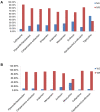Secondary Infections in Hospitalized COVID-19 Patients: Indian Experience
- PMID: 34079300
- PMCID: PMC8164345
- DOI: 10.2147/IDR.S299774
Secondary Infections in Hospitalized COVID-19 Patients: Indian Experience
Abstract
Purpose: Critically ill coronavirus disease 2019 (COVID-19) patients need hospitalization which increases their risk of acquiring secondary bacterial and fungal infections. The practice of empiric antimicrobial prescription, due to limited diagnostic capabilities of many hospitals, has the potential to escalate an already worrisome antimicrobial resistance (AMR) situation in India. This study reports the prevalence and profiles of secondary infections (SIs) and clinical outcomes in hospitalized COVID-19 patients in India.
Patients and methods: A retrospective study of secondary infections in patients admitted in intensive care units (ICUs) and wards of ten hospitals of the Indian Council of Medical Research (ICMR) AMR surveillance network, between June and August 2020, was undertaken. The demographic data, time of infection after admission, microbiological and antimicrobial resistance data of secondary infections, and clinical outcome data of the admitted COVID-19 patients were collated.
Results: Out of 17,534 admitted patients, 3.6% of patients developed secondary bacterial or fungal infections. The mortality among patients who developed secondary infections was 56.7% against an overall mortality of 10.6% in total admitted COVID-19 patients. Gram-negative bacteria were isolated from 78% of patients. Klebsiella pneumoniae (29%) was the predominant pathogen, followed by Acinetobacter baumannii (21%). Thirty-five percent of patients reported polymicrobial infections, including fungal infections. High levels of carbapenem resistance was seen in A. baumannii (92.6%) followed by K. pneumoniae (72.8%).
Conclusion: Predominance of Gram-negative pathogens in COVID-19 patients coupled with high rates of resistance to higher generation antimicrobials is an alarming finding. A high rate of mortality in patients with secondary infections warrants extra caution to improve the infection control practices and practice of antimicrobial stewardship interventions not only to save patient lives but also prevent selection of drug-resistant infections, to which the current situation is very conducive.
Keywords: COVID-19; antibiotics; antimicrobial resistance; hospital acquired infections; secondary infections.
© 2021 Vijay et al.
Conflict of interest statement
Dr Camilla Rodrigues reports personal fees from Pfizer, Sanofi, B Braun, Becton Dickinson, Biomerieux, Cipla and Glenmark, outside the submitted work. The authors declare that they have no other potential conflict of interests regarding this work.
Figures




Similar articles
-
Secondary infections modify the overall course of hospitalized patients with COVID-19: a retrospective study from a network of hospitals across North India.IJID Reg. 2022 Jun;3:44-53. doi: 10.1016/j.ijregi.2022.02.008. Epub 2022 Feb 23. IJID Reg. 2022. PMID: 35720143 Free PMC article.
-
Secondary Bacterial Infection and Clinical Characteristics in Patients With COVID-19 Admitted to Two Intensive Care Units of an Academic Hospital in Iran During the First Wave of the Pandemic.Front Cell Infect Microbiol. 2022 Feb 23;12:784130. doi: 10.3389/fcimb.2022.784130. eCollection 2022. Front Cell Infect Microbiol. 2022. PMID: 35281440 Free PMC article.
-
Profile of co-infections & secondary infections in COVID-19 patients at a dedicated COVID-19 facility of a tertiary care Indian hospital: Implication on antimicrobial resistance.Indian J Med Microbiol. 2021 Apr;39(2):147-153. doi: 10.1016/j.ijmmb.2020.10.014. Epub 2020 Nov 2. Indian J Med Microbiol. 2021. PMID: 33966856 Free PMC article. Review.
-
Bacterial Epidemiology and Antimicrobial Resistance Profiles in Children Reported by the ISPED Program in China, 2016 to 2020.Microbiol Spectr. 2021 Dec 22;9(3):e0028321. doi: 10.1128/Spectrum.00283-21. Epub 2021 Nov 3. Microbiol Spectr. 2021. PMID: 34730410 Free PMC article.
-
State-of-the-art review of secondary pulmonary infections in patients with COVID-19 pneumonia.Infection. 2021 Aug;49(4):591-605. doi: 10.1007/s15010-021-01602-z. Epub 2021 Mar 11. Infection. 2021. PMID: 33709380 Free PMC article. Review.
Cited by
-
Molecular Typing and Resistance Profile of Acinetobacter baumannii Isolates during the COVID-19 Pandemic: Findings from the "EPIRADIOCLINF" Project.Antibiotics (Basel). 2023 Oct 19;12(10):1551. doi: 10.3390/antibiotics12101551. Antibiotics (Basel). 2023. PMID: 37887252 Free PMC article.
-
COVID-19 Reinfection Rate and Related Risk Factors in Fars Province, Iran: A Retrospective Cohort Study.Iran J Med Sci. 2023 May;48(3):302-312. doi: 10.30476/IJMS.2022.94615.2598. Iran J Med Sci. 2023. PMID: 37791328 Free PMC article.
-
Aftermath of COVID-19 and Critical Care in India.Indian J Crit Care Med. 2021 Oct;25(10):1173-1175. doi: 10.5005/jp-journals-10071-23987. Indian J Crit Care Med. 2021. PMID: 34916751 Free PMC article.
-
Delineating the impact of COVID-19 on antimicrobial resistance: An Indian perspective.Sci Total Environ. 2022 Apr 20;818:151702. doi: 10.1016/j.scitotenv.2021.151702. Epub 2021 Nov 16. Sci Total Environ. 2022. PMID: 34798093 Free PMC article. Review.
-
Mycotic infections - mucormycosis and oral candidiasis associated with Covid-19: a significant and challenging association.J Oral Microbiol. 2021 Aug 26;13(1):1967699. doi: 10.1080/20002297.2021.1967699. eCollection 2021. J Oral Microbiol. 2021. PMID: 34527182 Free PMC article.
References
-
- World Health Organization. Coronavirus disease (COVID-19) pandemic. Available from: https://covid19.who.int. Accessed March14, 2021.
-
- COVID-19 pandemic in India. Available from: https://covid19.who.int/region/searo/country/in. Accessed March14, 2020.
LinkOut - more resources
Full Text Sources

